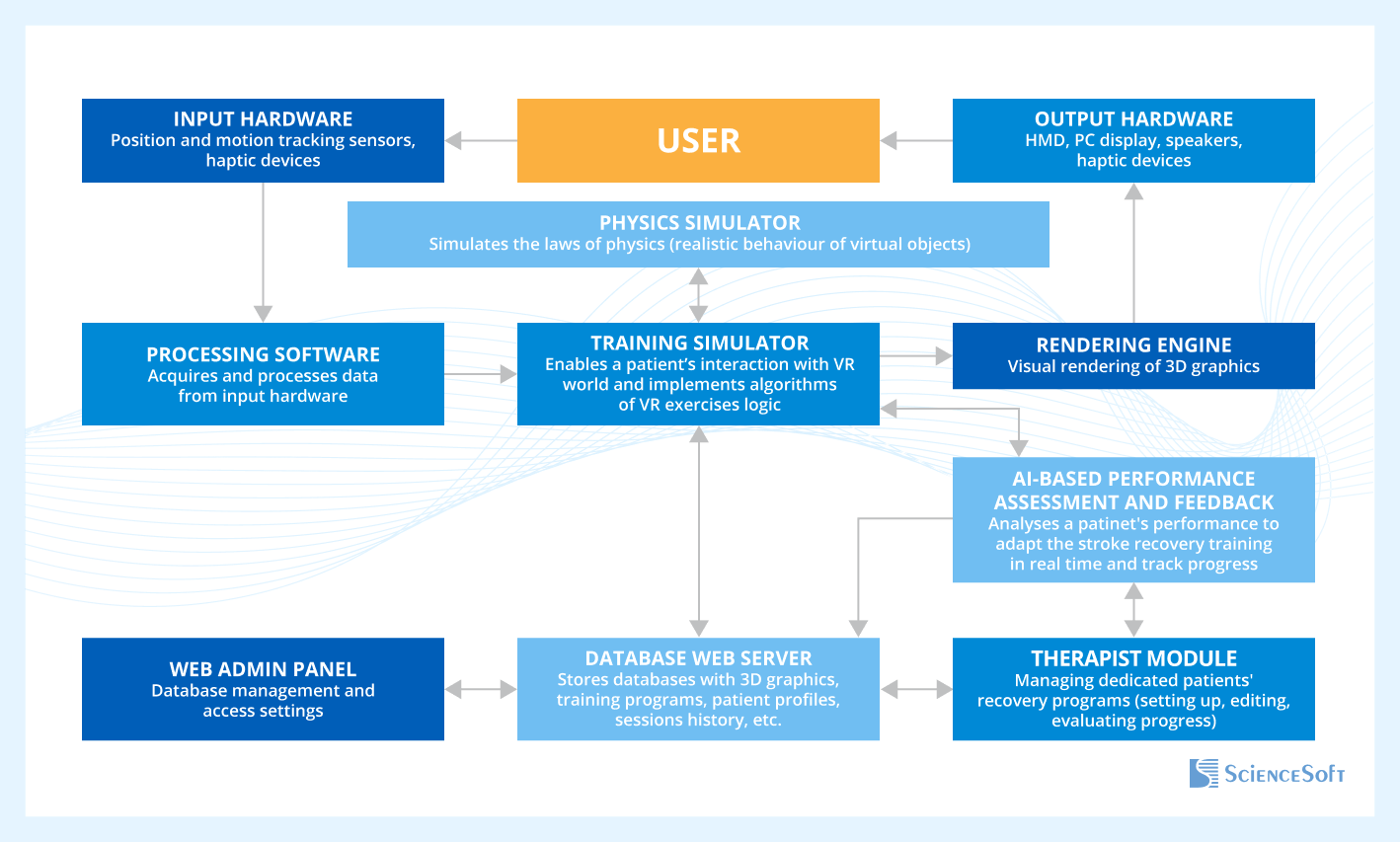Virtual Reality for Stroke Rehabilitation
Overview
When applied for stroke rehabilitation, VR technology helps improve limb motor functions in patients. By imitating the real world, VR solutions engage patients in the rehabilitation process and motivate them thanks to implemented gamification techniques.
About ScienceSoft
ScienceSoft is an international software development and IT consulting company. Being ISO 13485-certified, we design and develop medical software according to the requirements of the FDA and the Council of the European Union. You can learn more about our VR software development offering or drop us a line to talk over your product idea directly.
Market Info: VR Technology in Stroke Rehabilitation
The healthcare VR market hit $628 million in 2022 and is forecasted to reach $6.2 billion by 2029. The software segment will grow at a CAGR of 38.7% during this period. VR for stroke recovery remains a promising application of the technology as it enables higher patient engagement compared to conventional therapy.
How Virtual Reality for Stroke Rehabilitation Works
VR system architecture

Use cases
Regaining physical function
VR exercises where a patient has to manipulate virtual objects (pick up, squeeze, move, etc.). Repetitive goal-oriented exercises with an increasing difficulty help a patient’s brain build new neural pathways that stimulate the improvement of motor skills.
Improving cognitive abilities
VR exercises with scenarios of a varying cognitive load, e.g., from remembering the sequence of objects to piloting a plane. The focus is on attention, memory, and spatial orientation impairments after a stroke.
Core features
Patient profile storage
Each patient has a profile with their VR sessions history. Therapists use a home page of the VR application to switch between profiles and see patients’ progress in stroke recovery and their stumbling blocks.
Rehabilitation exercises library
A collection of exercises of various types, scenarios and complexity to cater to different groups of post-stroke patients and increase their engagement.
Rehabilitation program editor
The editor allows a therapist to build personalized programs (choose and modify exercises, set up a training schedule, etc.) for stroke recovery of each patient and adjust the programs when needed.
Real-time program adaptivity
With machine learning algorithms integrated with VR, the intensity of an exercise is automatically adjusted in real time based on a patient’s performance (e.g., the speed or the number of moving objects is increased/decreased).
Progress tracking
The AI system evaluates a patient’s performance according to the pre-set metrics. The results are tracked over time on a dashboard to build a picture of the patient’s stroke recovery.
Real-time feedback
A patient receives positive visual and audio reinforcement of the right actions in VR training (scores, verbal encouragements) aimed at boosting their motivation.
Telerehabilitation
Portable VR hardware allows post-stroke training at home under the supervision of a therapist or independently at later stages of recovery. It increases the opportunity of building more efficient long-term stroke recovery programs and broadens the number of patients that can access such rehabilitation.
Success Stories of Virtual Reality for Stroke Rehabilitation
A Swiss startup that invented MindMaze, an FDA-approved brain telerehabilitation platform powered by VR and AI, got $100 million in investments in 2016 and is currently valued at $1 billion.
An Austrian startup Rewellio that created a VR platform specifically for post-stroke treatment generated €800K in investments in 2019. The platform got certified in the US (FDA), Europe (CE), Canada, and Australia.
Challenges of VR for Stroke Rehabilitation
Challenge #1
Post-stroke patients without movement ability saved in the impaired limb can’t perform standard VR rehabilitation exercises.
Check out the solution
Challenge #2
Patients can make compensatory movements while training motor skills (e.g., trunk rotation or excessive leaning forward), which activates the “wrong” muscles and becomes an obstacle to recovery. Many VR systems can’t assess motion quality in detail and consider the exercise complete even if it’s done with compensatory patterns.
Check out the solution
Costs of Virtual Reality for Stroke Rehabilitation
General cost factors
- Volume of the content (number of 3D models) and software to render it.
- Number of user roles (basic users – patients; advanced users – therapists; admins).
- Number and complexity of training programs.
- VR testing (clinical validation and usability testing) and optimization.
Additional cost factors
- VR hardware (from commercial to custom-built).
- Development and integration with AI technology (for user performance assessment).
Operational costs
- Cloud services (based on the volume of cloud resources demanded).

The cost of average VR software for stroke rehabilitation may vary from $200,000 to $300,000, according to ScienceSoft’s healthcare IT experts.
Want to know the cost of your VR stroke rehabilitation solution?
VR for Stroke Rehabilitation: Consulting and Development by ScienceSoft
ScienceSoft offers development of VR for rehabilitation solutions, including VR for stroke rehabilitation, drawing on 20-year experience in healthcare software development and 29-year experience in 3D modeling. You set goals, we drive the project to fulfill them in spite of time and budget constraints, as well as changing requirements.






